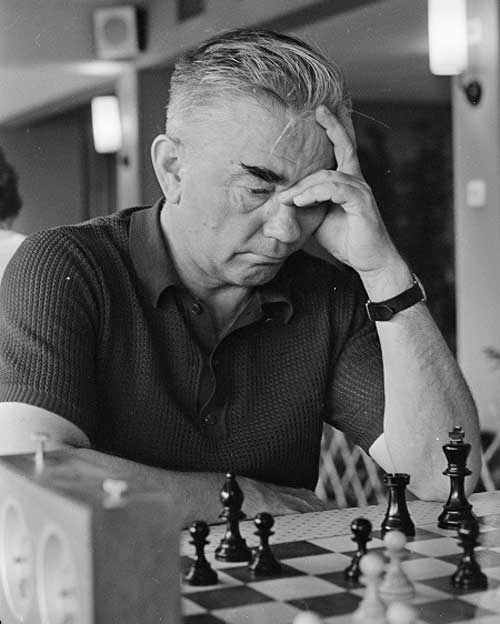Chess is a game of logical calculation and deep strategy. Grandmasters are admired for their extraordinary understanding.
Alexander Kotov’s book offers readers an in-depth look into the thought processes that distinguish elite players from the average player, helping them understand the strategic nuances of chess at a deeper level.
In this review, we will break down the key aspects of the book and weigh the pros and cons of Kotov’s approach to chess analysis in his book.
About the Writer and the Book

Alexander Kotov (1913 – 1981) was not only a grandmaster with a peak FIDE Chess rating of 2620 but also a prolific chess writer whose work has sparked debate among chess enthusiasts.
While some criticize him for his Soviet affiliations and what they see as an overly rigid view of thinking in his chess books, there’s no denying his influence on the chess world. Think Like a Grandmaster is the first book in a three-part series, followed by Play Like a Grandmaster and Train Like a Grandmaster.
Kotov’s central idea is that a player’s strength largely depends on the systematic organization of their thinking processes, which is essential for making sound strategic decisions in chess.
Although many top players have since claimed that they rely more on intuition and pattern recognition, Kotov’s methodical approach has impacted how many non-master players think about chess.
Book Content Summary
Think Like a Grandmaster is centered on a comprehensive exploration of the critical skill of analysis. This skill sets grandmasters apart from average players in chess. The book is divided into several thematic sections:
- Analysis of Variations: The first chapter examines the disadvantages of unsystematic thinking. Kotov highlights common errors such as secular reasoning, repetitive analysis, and a vague position evaluation approach. He illustrates how even the absolute best players can fall into the trap of overthinking, which may ultimately lead to time travel and poor moves. He also notes the exploration of candidate moves and the tree of analysis, a step-by-step method for disciplined thinking.
- Positional Judgment: This chapter is one of the most interesting, focusing on judging positions. Here, Kotov outlines classical middle-game positions and uses examples from his own game to explain how strong players access the board. The chapter also offers practical advice on identifying weaknesses and strengths in a position, making it one of the most valuable sections for anyone looking to improve their middle-game play.
- Practical Chess Thoughts: This book discusses broader chess concepts beyond the logic of analysis. Kotov discusses whether to recheck your analysis, trust your opponent’s moves, and handle time pressure. Kotov’s insight into why blunders occur is instructive and essential for average players to learn.
Notably, a chapter in the book mentions what is now known as “Kotov Syndrome,” a term that describes a scenario in which a player, overwhelmed by the complexity of analysis, loses track of their reasoning, runs out of time, and makes a critical error. Interestingly, this term is so popular that it has made its way into pop culture.
Who Is This Book For?

Think Like a Grandmaster is especially helpful for intermediate chess players who have progressed beyond casual play and are actively honing their strategic thinking skills.
If you struggle with disorganized thinking during games or frequently doubt your moves, Kotov’s structured approach to analysis could offer the clarity and direction you seek.
While advanced players may rely more on instinct and pattern recognition, beginners and club players can gain a structured framework to improve their decision-making process.
Pros of the Book
- Instructive Value: The book provides an in-depth look at the mechanics of analysis, helping readers understand what separates good moves from blunders.
- Practical Examples: The book is filled with illustrative games and positions, especially in the chapter on positional judgment, making the concepts easy to understand and follow.
- Timeless Advice: Despite some controversy, the core ideas about disciplined thinking and methodical analysis remain valuable, particularly for those still developing their chess skills.
- Engaging Narrative: Kotov’s personal anecdotes and humorous writing style make the reading experience both informative and entertaining.
Cons of the Book
- Rigid Methodology: Kotov’s emphasis on a highly structured “tree of analysis” may not resonate with every player. Many top-level competitors rely on more intuitive and flexible methods.
- Not for Beginners: The book is not ideal for first-time players of the game. The content is too technical and will be difficult to grasp.
- Debated Relevance: Some readers and chess experts question whether a strictly organized approach truly captures the dynamic and fluid nature of high-level chess thought.
Final Thoughts
Think Like a Grandmaster remains a crucial read for any chess enthusiast looking to supercharge and improve their chess.
Whether you’re a beginner looking to bring more structure to your analysis or a seasoned player curious about historical perspectives on chess strategy, Kotov’s work offers a unique blend of rigorous logical concepts and engaging storytelling.
